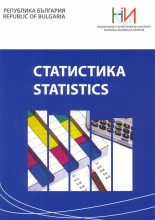The National Statistical Institute informs users of statistical information that No. 1/2015 ‘Statistics’ Magazine is published on the NSI’s website. The issue is in Bulgarian language with summaries in Bulgarian, English and Russian and includes sections as follows:
The section ‘Theory and methodology of statistical studies’ contains the article:
• ‘The elementary and functional additive index factor analysis and its unique solutions with discrete odd function of the mathematical signum’ - author Professor Emil Hristov
The two discrete statistical factor analyses - additive and index of each dependent variable from two multiplicatively connected factor variables are combined in a common elementary functional analysis with discrete data. That is the first and most necessary factor analysis in the statistical practice and in all applications and scientific studies with discrete data.
The initial and definitive form of the functional analysis is the additive one because its solutions contain explicitly only real existing precise net effects and eventual joint effects (increases and decreases) of the dependent variable of unidirectional and multidirectional changes in the factors р (prices) and q (amounts). The additive factor analysis is decided after turning the multiplicative model into linear additive factor model using a theoretical mathematical criterion - discrete odd function mathematical signum (h). Index factor analysis can be carried out independently without prior additive factor analysis.
Any multiplicative models in all applied statistics in which discrete dependent variable are represented by the product of two discrete factor variable could be solved with the displayed methodology. The next article will display and summarize both forms (additive and index) of elementary functional analysis of the production of homogeneous set (finite set) of one and the same commodity and a diverse set (finite set) of various commodities.
The section ‘Statistical research and analysis’ includes the article:
• ‘Agrarian statistics in Bulgaria’ - author Professor Polya Angelova, Economic Academy ‘D. Tzenov’ - Svishtov
Agrarian Statistics is one of the first separately conducted types of statistics in Bulgaria. Its development has passed through different historical and socio-economic stages, each of which has left its mark on its image. The article presents the main aspects of the organization and methodology of agricultural statistics from its beginning until our days, and based on the rich bibliography in the field are displayed regularities in its state and development. A thorough review and periodization of statistical surveys in agriculture have been made with an emphasis on their methodological aspects and the basic elements of their organization – range, object, periodicity, form of conduct and information sources. The retrospective analysis is the basis for comparison and evaluation of contemporary agricultural statistics whose activity over the past decade is a qualitatively new stage in its development, in line with European standards.
The section ‘Historical development of statistical theory and practice’ contains the article:
• ‘Population growth in medieval Bulgaria’ - author Professor Dimitar Arkadiev, Veliko Turnovo ‘St. Cyril and Methodius’ University
The article discusses the problem of population numbers and its growth in medieval Bulgaria (VII - XIV century). It is stated that the source base is limited. Discussed are the available estimates of the population numbers provided by various authors. The author of the article offers his assessment of the population numbers in the modern territorial borders of Bulgaria. It is based on the number of settlements, housing and the people living in them at the beginning of VII century according to the archaeological studies. Another strong point is the population of Vidin kingdom in the middle of the fourteenth century (600 thousand people). The results are compared with the estimates obtained by other methods described in the literature. The population numbers at the beginning of VII century (600) is estimated at 800 thousand people and by the middle of the fourteenth century (1350) - to 2230 thousand people. Between them the evaluations are every 50 years. They are determined by modeling the growth with the number of years in wars, natural disasters, epidemics and other. Population has increased about three times between the initial and final assessment.
The section Information, reviews, consultations contains a material for participation in the training course in The Hague, Netherlands:
• Information on participation in training ‘National accounts in practice’, held in The Hague, Netherlands - author Julia Panayotova, state expert, National Statistical Institute
The training course held 16 - 27 November 2014 in The Hague, Netherlands, organized by the Statistical Office of the Netherlands and Eurostat, was attended by representatives of 18 statistical offices, the National Bank of Belgium and the European Central Bank. Lecturers were mainly from the Statistical Office of the Netherlands.
The purpose of the meeting was the acquisition of theoretical and practical knowledge in the field of quarterly and annual national accounts.
Each lecture was followed by practical exercises and discussions. The exercises aimed to demonstrate the practical development of the overall system of national accounts.
‘P. Volov’ № 2 Str., Sofia 1038.



